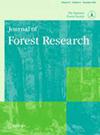Importance of large-diameter conifer snags for saproxylic beetle (Cerambycidae) assemblages in old-growth remnants in Japan
IF 1.1
4区 农林科学
Q3 FORESTRY
引用次数: 0
Abstract
ABSTRACTConversion of old-growth forests to managed forests reduces the amount and variety of dead wood, particularly large snags (standing dead trees) are disappeared. Therefore, organisms that rely on large snags are considered to be severely affected by forest practices that convert old-growth forests to managed forests. We examined the effect of snag characteristics (diameter, bark cover, and decay gradient) on longicorn beetle (Cerambycidae) assemblages to search for species that prefer large-diameter snags in two old-growth remnants in a cool-temperate mixed forest and a sub-boreal conifer forest in Hokkaido, Japan. We collected beetles using window traps attached to conifer snags belonging to genus Abies and Picea and evaluated how snag characteristics affected beetles that feed on conifers with considering spatial autocorrelation. Species richness and total abundance were not associated with any of the snag characteristics. However, permutation tests in redundancy analysis revealed that snag diameter and bark cover affected species composition in the mixed forest, while only snag diameter had a significant effect in the conifer forest. Two (Macroleptura regalis and Prionus insularis insularis) and one (Sachalinobia koltzei) species preferred large-diameter snags in the mixed forest and the conifer forest, respectively. These species should be used as conservation targets to reduce the impacts of forest practices on saproxylic beetles. In contrast, one species (Molorchus minor fuscus) preferred small-diameter snags in the conifer forest. To conserve species that rely on large snags, we should maintain large snags in harvesting operations and retain large living trees for the future recruitment of large snags.KEYWORDS: Community analysisdead woodforest practiceinsect conservationspatial autocorrelation AcknowledgementsWe thank S. Ishibashi and S. Iida for providing information on the study sites, T. Yoshihisa and K. Sakakibara for collecting insects and helping fieldwork, and A. Komatsu for sorting insect samples.Disclosure statementNo potential conflict of interest was reported by the author(s).Supplementary dataSupplemental data for this article can be accessed online at https://doi.org/10.1080/13416979.2023.2257464Additional informationFundingThis study was supported by JSPS KAKENHI grant number JP25252030.大直径针叶树残枝对日本古生代腐木甲虫(天牛科)组合的重要性
【摘要】原生林向经营林的转变减少了枯木的数量和种类,特别是大的枯木消失了。因此,人们认为,将原生林转变为管理林的森林做法严重影响了依赖大树枝的生物。在日本北海道寒温带混交林和亚北方针叶林的两处原始残余物中,研究了障碍物特征(直径、树皮覆盖度和腐烂梯度)对天牛甲虫(天牛科)组合的影响,以寻找偏爱大直径障碍物的天牛甲虫。采用冷杉属和云杉属针叶树枝条上的窗诱法采集甲虫,在考虑空间自相关的情况下,评估了枝条特征对以针叶树为食的甲虫的影响。物种丰富度和总丰度与各特征无关。然而,冗余分析中的排列试验表明,在混交林中,树干直径和树皮覆盖对物种组成有影响,而在针叶林中,只有树干直径对物种组成有显著影响。两种(Macroleptura regalis和Prionus insularis insularis)和一种(Sachalinobia koltzei)分别在混交林和针叶林中偏爱大直径的树枝。这些物种应作为保护目标,以减少森林实践对腐木甲虫的影响。相比之下,一个物种(Molorchus minor fuscus)在针叶林中更喜欢小直径的树枝。为了保护依赖大树枝的物种,我们应该在采伐过程中保留大树枝,并保留大的活树,以便将来补充大树枝。我们感谢S. Ishibashi和S. Iida提供了研究地点的信息,T. Yoshihisa和K. Sakakibara收集了昆虫并帮助进行了实地调查,A. Komatsu对昆虫样本进行了分类。披露声明作者未报告潜在的利益冲突。补充数据本文的补充数据可在线访问https://doi.org/10.1080/13416979.2023.2257464Additional informationfunding本研究由JSPS KAKENHI资助,资助号为JP25252030。
本文章由计算机程序翻译,如有差异,请以英文原文为准。
求助全文
约1分钟内获得全文
求助全文
来源期刊

Journal of Forest Research
农林科学-林学
CiteScore
3.00
自引率
6.70%
发文量
62
审稿时长
3 months
期刊介绍:
Journal of Forest Research publishes original articles, reviews, and short communications. It covers all aspects of forest research, both basic and applied, with the aim of encouraging international communication between scientists in different fields who share a common interest in forest science.
 求助内容:
求助内容: 应助结果提醒方式:
应助结果提醒方式:


